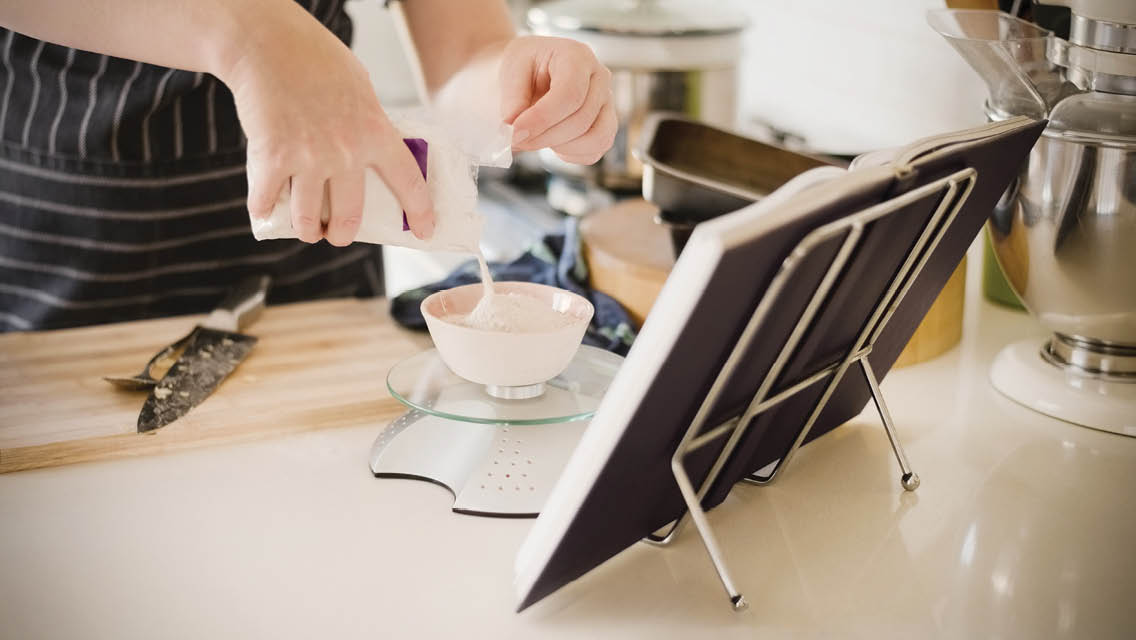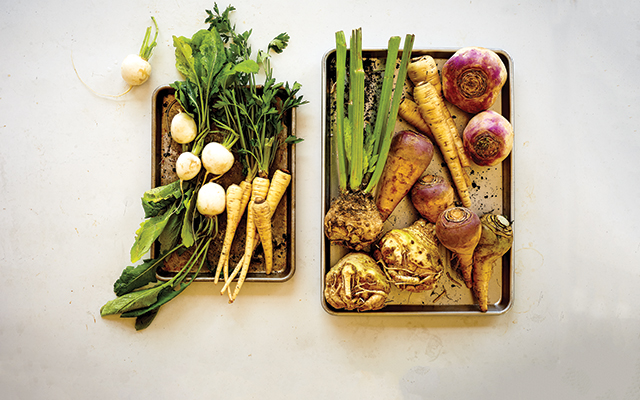Al Dente
Much modern cooking terminology comes from French cuisine, but “al dente” is purely Italian, and it’s mostly used to refer to the doneness of pasta (and sometimes rice). Al dente means “to the tooth,” or tender yet firm when bitten. It’s not only about texture: Al dente pasta has a lower glycemic index, which means more stable blood sugar.
With a little practice and taste-testing, you can make perfectly al dente pasta, just like a true nonna. Get started with chef José Andrés’s recipe for Pasta With Eggplant and Chickpeas at Pasta With Eggplant and Chickpeas.
Blanch
Blanching involves plunging food — most often vegetables — into boiling water for a short time, followed immediately by shocking (see further down). This technique preserves nutrients, which can often degrade with other cooking methods.
It also prevents the loss of flavor, color, and texture, particularly for vegetables that you’re going to can or freeze. Blanching is brilliant for taming the bitterness of leafy greens, or for any time you want a tender-crisp — but not crunchy and raw — veggie.
Braise
Braising is a combination of dry- and moist-heat cooking: Start by browning your protein (often a large, tough cut of meat), then add enough liquid to partially cover and simmer. While braising, the fat renders, tissues dissolve, and collagen breaks down into gelatin, making the meat more tender.
Tough cuts like short ribs, oxtail, chuck roast, and pork shoulder are among the most popular picks for the braising pot. Chicken thighs, with their higher fat content, are also a good choice. Plant-based eaters can easily braise vegetables solo — just make sure to include fat to add depth and richness, like in our recipe for Braised Greens.
Caramelize
Caramelization is common in cooking; it occurs anytime sugar is placed over heat. You can caramelize pure sugar, which is how you make caramel sauce, but it also occurs when vegetables and fruits are cooked — the sugars in the produce begin to brown and develop a toasty, savory flavor.
Caramelization is a dry-heat cooking method, meaning it doesn’t happen if you’re cooking with water (like steaming or boiling). Alliums do particularly well with this treatment, as in our Caramelized-Onion Dip.
Chiffonade
Those whisper-thin slips of herbs garnishing a soup, salad, or pasta are created by a technique known as chiffonade. Why bother (beyond aesthetics, of course)? When you chiffonade greens, it releases their beautiful aromas. That’s one reason why basil is so often destined for this treatment.
You’d struggle to chiffonade cilantro, thyme, and rosemary because their leaves are too small. But it’s deceptively easy to do with bigger leaves, like mint, sage, spinach, chard, and kale. Layer leaves on top of one another, then roll them up tight and use a super-sharp knife to slice them into thin ribbons.
A sharp knife is crucial for this technique: Attempting to chiffonade with a dull knife can cause the blade to tear and bruise the leaves rather than slice cleanly through them, discoloring tender greens and muting their flavor.
Those ribbons of leafy greens can be wilted into soups, stews, stir-fries, or any other one-pot meal that could use something green. You can also sprinkle chiffonaded fresh herbs over your favorite dishes as an elegant finishing touch.
Deglaze
Deglazing is a not-so-secret way to imbue dishes with exceptional flavor. It’s as simple as pouring liquid into a hot pan after cooking something over high heat, then gently scraping to loosen the bits from the bottom. Also known as fond, those brown bits are the deeply flavorful result of caramelization that occurs while cooking.
Typically, broth, stock, and wine are go-tos for deglazing because of the flavor they contribute, but nearly any liquid — juice, beer, and even water — works. Deglazing occurs in familiar dishes like penne alla vodka and beef stew. You can splash a little cognac into a roasting pan to make gorgeous gravy for roast chicken. Or try the method with our recipe for Mussels in Lemongrass Coconut Broth.
Emulsify
As the saying goes, oil and water don’t mix — unless, of course, you emulsify them. Emulsifying involves combining nonhomogenous liquids (typically water and oil or some other kind of fat) so they remain fused — through vigorous shaking, dedicated whisking, or thorough mixing. An emulsion can be temporary, as happens in a salad dressing made with oil and vinegar, or permanent, as in mayonnaise, butter, and cream.
Fold
A technique often used in baking, folding involves gently incorporating a light mixture into a heavier one, usually by slowly scraping the bottom of the bowl and scooping the mix over itself in a “folding” motion. Folding is commonly used with airy ingredients like beaten egg whites or whipped cream — you often want to incorporate these mixtures into a heavier batter without deflating the air that you’ve whipped into them.
Poach
Like its siblings boiling and simmering, poaching involves cooking food submerged in liquids but at low heat. Stock, wine, and water are all standard, but as with deglazing, most any liquid will do. Beer, cider, coconut milk, and juice make beautiful poaching liquids.
You’re likely familiar with poached eggs (here’s a quick how-to on poaching an egg), but fish, chicken, and fruit also take well to this method, which preserves delicate, nuanced flavors and textures that may be overwhelmed with higher-heat cooking.
The secret to poaching? Patience. Low and slow is the key here. For a lovely classic dessert, try our Poached Pears.
Shock
A technique often used immediately after blanching, shocking is the act of submerging partially cooked veggies in an ice bath to stop the cooking process. Shocking keeps vegetables crisp and preserves their bright colors. You might also use this technique after boiling eggs to make them easier to peel. Try our method for the perfect boiled egg at “How to Boil an Egg.”
Sous Vide
Pronounced “sue-veed,” this term means “under vacuum” in French and involves vacuum-sealing food, then cooking it in a water bath at a low temperature. It’s widely considered one of the best ways to achieve an exact degree of doneness, thanks to the strict temperature control.
You can use the sous vide technique on nearly anything — meat, poultry, fish, vegetables, and even eggs. But you need special kitchen gear: a vacuum sealer, an immersion circulator, and a sous vide water bath. Even if you never try this at home, you might encounter the term while perusing a restaurant menu.
Sweat
A simple way to coax flavor from chopped vegetables, sweating is often one of the first steps when preparing soups, stews, and sauces. The goal here isn’t to brown the veggies; rather, you want to gently heat them with a sprinkle of salt to soften them and release their flavors.
As the vegetables cook, you’ll see small beads of “sweat” form on the surface — that’s moisture being drawn out, aided by the salt, which concentrates their flavor.
The best candidates for sweating are aromatic vegetables, which you’ll recognize as the building blocks of many dishes: celery, carrots, peppers, fennel, and alliums (think onions, shallots, garlic, and leeks).
The next time you’re making a casserole or a ragu, don’t be afraid to let those veggies sweat to form the base for a super flavorful dish.
This article originally appeared as “A Glossary of Lesser-Known Cooking Terms” in the May 2023 issue of Experience Life.





This Post Has 0 Comments